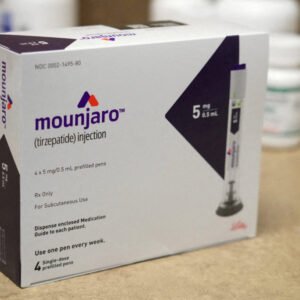Understanding Mounjaro: A Revolutionary Treatment for Type 2 Diabetes and Weight Loss
Introduction to Mounjaro (Tirzepatide)
Mounjaro, a groundbreaking medication for managing type 2 diabetes, contains the active ingredient tirzepatide. This novel therapeutic agent has garnered significant attention due to its recent approval by the U.S. Food and Drug Administration (FDA) as a treatment option for individuals with type 2 diabetes. The primary role of Mounjaro is to optimize blood sugar control, a critical factor for those living with this chronic condition.
Tirzepatide operates through a unique mechanism, mimicking the effects of two incretin hormones, GLP-1 and GIP. This dual action enables Mounjaro to effectively stimulate insulin secretion while suppressing glucagon release, facilitating a comprehensive approach to blood sugar regulation. By enhancing insulin sensitivity and promoting glucose-dependent insulin secretion, tirzepatide enables patients to achieve tighter glycemic control, which is vital in mitigating the long-term complications of diabetes.
Moreover, Mounjaro addresses another pressing issue often faced by individuals with type 2 diabetes: obesity. Many patients struggle with weight management, which can complicate their diabetes treatment. The administration of tirzepatide not only assists in lowering blood sugar levels but has also been linked to significant weight loss, making it a unique solution for those who are overweight or obese. Clinical trials have demonstrated that participants experienced considerable reductions in body weight alongside improvements in their glycemic control. This dual benefit positions Mounjaro as an invaluable tool in the comprehensive management of type 2 diabetes and its related challenges.
As healthcare providers continue to evaluate and implement innovative treatments, Mounjaro represents a promising advancement. Its ability to simultaneously aid in blood glucose management and support weight loss offers hope for better health outcomes among individuals grappling with type 2 diabetes and obesity.
How Mounjaro Works: The Mechanism of Action
Mounjaro, containing the active ingredient tirzepatide, offers a novel approach to the management of type 2 diabetes and weight loss. Its therapeutic efficacy lies in its multifaceted mechanism of action that targets glycogen metabolism, appetite regulation, and insulin release. Tirzepatide operates primarily by acting as an agonist of the glucose-dependent insulinotropic polypeptide (GIP) and the glucagon-like peptide-1 (GLP-1) receptors. By stimulating these receptors, Mounjaro enhances insulin secretion from pancreatic beta cells when blood glucose levels are elevated.
In addition to promoting insulin release, tirzepatide significantly reduces hepatic glucose production. The reduction in sugar production in the liver is essential for maintaining better glycemic control, thus contributing to lower blood sugar levels. This dual action of stimulating insulin while inhibiting glucose production distinguishes Mounjaro from traditional treatments for diabetes, which typically focus solely on enhancing insulin action.
Another important aspect of Mounjaro’s mechanism of action is its influence on gastric emptying. The drug delays the rate at which food leaves the stomach, which leads to a prolonged feeling of fullness after meals. This delayed gastric emptying can be beneficial not only in managing post-prandial blood sugar spikes but also in aiding weight management. The reduced hunger signals can lower calorie intake, which can contribute to weight loss in individuals with excess weight, a common associated issue in type 2 diabetes.
In summary, the combined actions of enhancing insulin secretion, reducing hepatic glucose production, and delaying gastric emptying underscore the innovative therapeutic potential of Mounjaro for individuals struggling with type 2 diabetes and weight management. Understanding how Mounjaro works at the pharmacological level provides valuable insight into its role in contemporary diabetes treatment strategies.
Usage and Administration of Mounjaro
Mounjaro is an innovative medication designed to manage Type 2 diabetes and to assist in weight loss. Its active ingredient is tirzepatide, which functions by mimicking the effects of certain hormones that regulate blood sugar and appetite. The recommended dosage for Mounjaro begins at 2.5 mg once a week, and practitioners may adjust this dose based on patient response and tolerance, potentially increasing it to 5 mg, 7.5 mg, or 10 mg weekly. This gradual introduction helps in minimizing side effects while allowing the body to acclimate to the treatment.
Administration of Mounjaro is straightforward and can be performed by the patient at home. The medication comes pre-filled in a compatible injection pen that ensures ease of use. Patients are instructed to inject the solution subcutaneously in areas such as the abdomen, thigh, or upper arm. It is crucial to rotate the injection sites to prevent tissue irritation. Before administering the injection, patients should allow the pen to come to room temperature and follow specific steps outlined in the provided instructions, ensuring proper technique and dosage delivery.
Adhering to a diet and exercise regimen while using Mounjaro is essential for maximizing benefits. This medication is not a standalone solution; patients should aim for a balanced diet and regular physical activity to support their weight loss and blood sugar management efforts. Moreover, individuals new to this treatment should be aware of potential side effects, which may include nausea, vomiting, and gastrointestinal disturbances. Discussing these with a healthcare provider can provide reassurance and strategies for managing them. For effective self-administration, patients are encouraged to practice proper technique and monitor their body’s response to this revolutionary treatment.
Benefits of Mounjaro for Type 2 Diabetes Patients
Mounjaro, an innovative treatment for type 2 diabetes, offers several notable benefits for patients seeking to manage their condition more effectively. One of the primary advantages of this medication is its ability to significantly improve blood sugar control. Clinical studies have shown that patients using Mounjaro experienced marked reductions in hemoglobin A1c levels, a key indicator of long-term glucose management. This enhanced glycemic control not only mitigates the risk of diabetes-related complications but also provides patients with a greater sense of stability in their everyday lives.
In addition to its effects on blood sugar levels, Mounjaro has shown promising results in supporting weight loss, a critical factor for many individuals living with type 2 diabetes. Weight management can be a challenging aspect of diabetes care, and Mounjaro contributes to this by promoting appetite suppression and encouraging healthier eating habits. Patients often report significant weight loss during their treatment, which can further improve insulin sensitivity and contribute to better overall metabolic health.
Moreover, the overall quality of life for Mounjaro users has been reported to improve considerably. With better blood sugar control and successful weight management, patients find themselves experiencing enhanced energy levels and a greater ability to engage in physical activities. This holistic approach not only addresses the physiological aspects of diabetes management but also fosters emotional well-being. Testimonials from users frequently highlight these life-changing benefits, underscoring the medication’s role in fostering a healthier lifestyle, reestablishing confidence, and enhancing daily functioning.
Potential Side Effects and Considerations
As with any pharmaceutical treatment, Mounjaro, while offering significant benefits for those with Type 2 diabetes and weight loss, may present potential side effects that users should be mindful of. Common adverse effects reported by patients include gastrointestinal issues, such as nausea, vomiting, diarrhea, and constipation. These symptoms often occur as the body adjusts to the medication, and they can vary in intensity. It is crucial for individuals to remain vigilant about their reactions to Mounjaro, particularly during the initial phase of treatment.
Aside from gastrointestinal disturbances, some patients may experience headaches, fatigue, or changes in appetite. Rarely, more severe side effects may arise, including pancreatitis. Symptoms such as severe abdominal pain, persistent nausea, or vomiting warrant immediate medical consultation. It is advisable for patients to maintain open communication with their healthcare providers, discussing any persistent or concerning symptoms that occur while on Mounjaro.
Monitoring by a supportive healthcare team plays a pivotal role in the successful management of diabetes while using Mounjaro. Regular check-ups can help adjust dosages or switch treatment modalities if adverse effects become prohibitive. Patients should also be informed about the importance of adhering to lifestyle modifications, including diet and exercise, to maximize the benefits of Mounjaro. This combined approach will enhance overall effectiveness in managing Type 2 diabetes and supporting weight loss goals. An informed and proactive strategy will ensure that patients make the most of their treatment journey, addressing both the immediate side effects and the long-term management of their condition.







Reviews
There are no reviews yet.